| c |
cut,
cot,
coat,
cane,
cage,
collie,
came,
come,
cave,
coal,
cap,
card |
| k |
kale |
| q |
quit,
quiet,
quite,
queen |
| che |
ache |
|
|
|
Note: the red
letters all have the same sound |
|
|
|
Sound Type
This is an UNVOICED sound which means Your Vocal Cords DO
NOT vibrate when making the sound. |
 You CANNOT
LISTEN to your Vocal Cords vibrating if you cover
your ears with your hands. You CANNOT
LISTEN to your Vocal Cords vibrating if you cover
your ears with your hands.
Try covering your ears with your hands as Akiko is doing in
the picture.
Now make the sound of this lesson. You cannot listen to your vocal cords vibrating.
VERY GOOD |
 You
CANNOT FEEL your Vocal Cords vibrating if
you place your hands on your neck. You
CANNOT FEEL your Vocal Cords vibrating if
you place your hands on your neck.
Try placing your hands on your neck as Akiko is doing in the
picture.
Now make the sound of this lesson. You cannot feel your vocal
cords vibrating.
VERY GOOD |
|
The following diagram shows the most important parts of your
head and mouth used for pronouncing the sounds of English.
It also shows the location of your Vocal Cords. |
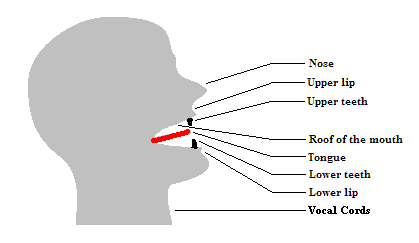 |
|
|
Mouth, lips,
and tongue position
The following descriptions explain the proper mouth, lips,
and tongue position when you make this sound. |
Your
mouth releases air which is then quickly stopped. |
Your lips should be slightly separated. |
The middle part of your tongue should be in the upper part of your
mouth. |
|
|
Additional Lessons |
 About These
Lessons About These
Lessons
The following classroom lessons are great for students
who want additional listening and reading practice. |
-
Travel America -
Beginner
Level. Do you love America and American
English? Learn before you travel. Facts and other
cool stuff about your favorite U.S. state. Great
English reading practice.
|
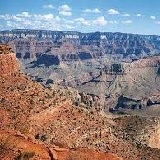 Travel
America - Indiana Travel
America - Indiana
(Beginner -
Reading)
Learn some interesting facts and read interesting
stories about Indiana. |
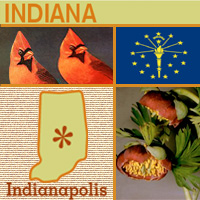 Indiana Indiana
Indiana means "land of the Indians." It joined the
Union in 1816 as the 19th state. Today, Indiana is a
state of mostly small towns and midsize cities. Its
largest city and capital is Indianapolis, where the
nation's most famous auto race, the Indianapolis
500, is held each year. The state's residents are
commonly referred to as "Hoosiers" although no one
seems certain just how the name originated. The
peony is the state flower. |
Indiana
State Flag
The blue and gold state flag of Indiana was adopted
by the 1917 General Assembly as part of the 1916 Indiana
centennial celebration. The original legislation described
the flag as the state "banner" (the name was changed to
"flag" by the 1955 General Assembly).
The winning design (by Paul Hadley of Mooresville, Indiana)
was selected during a competition sponsored by the Daughters
of the American Revolution.
The torch is a symbol for liberty and enlightenment; the
rays represent their far-reaching influence. Thirteen stars
in the outer circle symbolize the original thirteen states;
the inner semi-circle of five stars represents the next five
states to join the Union; and the large star above the torch
is a symbol of Indiana (in 1816 Indiana became the 19th
state). |
|
Source:
State Symbols USA |
|
|
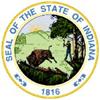 Indiana
State Facts Indiana
State Facts
Picture: state seal of Indiana |
|
State Capital |
Indianapolis |
|
Nickname |
Hoosier State |
|
Motto |
The Crossroads of America |
|
Statehood |
December 11,1816 (19th) |
|
Origin of Name |
"Land of the Indians." |
|
Largest Cities |
Indianapolis, Fort Wayne, Evansville, Gary, South
Bend |
|
Border States |
Illinois, Kentucky, Michigan, Ohio |
|
Area |
35,870 sq. mi., 38th largest |
|
State Bird |
Cardinal |
|
State Flower |
Peony |
|
State Tree |
Tulip tree (liriodendron tulipifera) |
|
State Song |
On the banks of the Wabash |
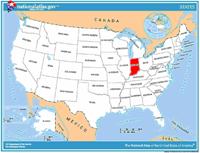 Travel and tourism
site for Indiana - This state travel and territorial
tourism site provides ideas for your vacations, meetings, and more. Travel and tourism
site for Indiana - This state travel and territorial
tourism site provides ideas for your vacations, meetings, and more. |
|
|
Indiana Stories |
|
|
Pekin Fourth of July Parade
Most towns have some kind of celebration on the
Fourth of July, but only the town of Pekin in
southern Indiana can boast that it has the longest
continually running celebration in the country. Can
you guess when it first started celebrating
Independence Day?
The first Pekin Fourth of July celebration took
place in 1830. Back then it was just a few
firecrackers and a gunshot in the air. Today, this
event is so popular that it draws noted speakers
including members of Congress, governors, college
presidents, judges, ministers, and teachers. The
town has only 1,500 people but it grows tenfold
during the celebration, with as many as 15,000
people attending.
Programs in the past have featured entertainment and
band music, including the "Spirit of 1776 Martial
Band." But the real highlight of the Pekin Fourth of
July celebration is the great parade. In early
years, when many people came in by train, a group
would meet the train and the parade would start
there. Now the parade is the main event of the day,
with novelty cars and trucks, floats of every kind,
bikes and horseback riders. |
|
|
Elwood Haynes
Have you ever heard of Elwood Haynes? Well, maybe
you have heard of some of his inventions: stainless
steel, the thermostat, and the horseless carriage.
Born in Portland, Indiana on October 14, 1857,
Elwood Haynes invented one of the first successful
gasoline-powered automobiles. He also invented
stainless steel, the thermostat used in houses, and
many other items. As a young boy, Haynes was curious
about how things worked. When he was 12 he read his
sister's college chemistry book, and by 15 he was
experimenting with alloys, metallic substances made
of two or more elements.
In 1886, natural gas was found in Haynes's hometown.
After this discovery he organized a company to
supply it to the town. In 1893, he purchased a
gasoline-powered engine and designed a "horseless
carriage," or auto. Haynes then went on to invent
the muffler and different metal alloys.
Specifically, he invented stellite alloy, which may
be his most important invention. This metal alloy
was the first step in the development of a series of
space-age alloys.
Are you interested in science and scientific
experiments? Maybe you could be the next Elwood
Haynes. |
|
|
Spirit of Vincennes
Rendezvous
Have you ever called someone's bluff? That's when
you see if a person meant what he or she said or was
just pretending. During the Revolutionary War, the
Colonists often had to bluff their way to victory.
That's what happened in 1779 in Vincennes, Indiana.
The battle was over the capture of Fort Sackville.
Lieutenant Colonel George Rogers Clark, the elder
brother of explorer William Clark, led the Colonial
forces. Clark relied on two things. First, he
counted on his troops' expert marksmanship. Second,
he used a classic military bluff. Clark had only 200
buckskin-clad pioneers as troops, but he had his men
raise enough flags for 600! Believing himself
overwhelmed by so many troops, British Lieutenant
Governor Henry Hamilton surrendered the fort. If
Hamilton had called Clark's bluff things might have
turned out differently.
The Spirit of Vincennes Rendezvous is a
Revolutionary War battle re-enactment held annually
on Memorial Day weekend. The event celebrates the
capture of Fort Sackville in 1779. Today,
participants of the Vincennes Rendezvous include
artisans, strolling musicians, and re-enactors
portraying soldiers and camp followers.
Revolution-era food is served, such as buffalo
burgers, turkey legs, and homemade pies. |
|
|
From the Emerald Isle to
Little Ireland: The Legacy of Farming in Brownsburg
Have you ever conducted an oral interview? An oral
interview documents history by asking someone
questions about his or her experiences in order to
learn what life was like through that person's eyes.
Do you know anyone whom you'd like to interview?
There are probably many people you know who could
tell you a lot about your community -- your parents,
aunts, uncles, grandparents or almost anyone who is
a few years older than you.
In Brownsburg, Indiana, Jill Taylor's third-grade
class created an oral history project. The children
made a list of interview questions for the farmers
of Little Ireland, an area settled by Irish
immigrants in the mid-1800s. They also took
photographs. After conducting the interviews, the
children wrote a report on what they learned,
selected the photographs, painted a rural Indiana
landscape, and hand-stitched a quilt that
commemorates the legacy of farming. Mrs. Taylor's
project was such a success that she was named
runner-up for Indiana Teacher of the Year.
Next time you have to do a project on something, try
and think of someone you can interview. That way you
will learn first-hand about the subject. |
|
|
Coca-Cola Circle City Classic
What does Coke have to do with college football?
Well, every year since 1984, Indianapolis, Indiana,
has celebrated its African American community with
the Coca-Cola Circle City Classic, a football game
between teams from historically black colleges. The
profits from the game go to the Indiana Black Expo
Scholarship Program, a fund that gives money to
young people for school.
What's a historically black college? It is a college
that was established in the United States at a time
when African Americans were not allowed to attend
college with white students. These institutions of
higher learning still exist today, providing
Americans of all backgrounds with a college
education.
The Indianapolis Black Alumni Council also holds a
college fair along with this football game. The fair
gives students and parents an opportunity to visit
with officials from more than 50 colleges and
universities. The events demonstrate African
American economic strength and show the importance
of education, while awarding annual scholarships
with the proceeds of the football game. |
|
|
Indiana's Indianapolis 500
You've probably heard of the Indianapolis 500, but
did you know that this auto race is held in a place
that some people call "The Brickyard"?
The Indianapolis Motor Speedway was originally built
in 1909 as a place where Indiana automobile
manufacturers could test and race their new cars. In
its early years, the Speedway was paved with bricks.
Even though most of the bricks have now been paved
over, people still call it "The Brickyard."
The Speedway was opened to the public in 1911 for
the Indy 500, a world-famous automobile race that
has taken place there almost every year since then.
More than 300,000 people come out to watch the race,
making it the biggest single-day sports event in the
world. The track is 2.5 miles around. The race
itself is 500 miles long, however, so the cars have
to make 200 laps around the track to complete the
race. |
|
|
Growing Up on the St. Joseph
River
People cannot live without water. So it makes sense
that communities are established near significant
bodies of water.
In South Bend, Indiana, the St. Joseph River has
always been at the heart of the city. The St. Joseph
River begins in Michigan, flows into Indiana and
then into Lake Michigan. All in all, it travels a
210-mile journey. In fact, the name South Bend comes
from the great bend that the river takes there.
The river has been important to Indiana for a long
time, encouraging people such as the Miami and
Potawatomi Indians to live there. Later, immigrants
settled there as well. First it was the French in
the 1600s, then the Hispanics and Latinos. The
French explorer Sieur LaSalle was the first white
man to float on the St. Joseph, in 1679.
The town of South Bend still celebrates its history
along the St. Joseph River. Kee-Boon-Mein-Kaa is a
huckleberry harvest festival in South Bend that is
hosted by the Potawatomi Indian Nation. This
festival includes American Indian dance
performances, delicious things to eat and crafts to
admire. |
|
Source:
Library of Congress |
|
 National
Forests of Indiana National
Forests of Indiana
The following is a description of national
forests in the state
of Indiana. There are no national parks or
monuments in this state. If you plan to visit or live in
Indiana for awhile then you should
definitely plan to visit some of these
fantastic places. |
|
|
|
National Forests |
 Hoosier Hoosier
The Pioneer Mothers Memorial Forest is 88
acres (36 ha) of old-growth forest in
Hoosier National Forest. The forest's
Charles C. Deam Wilderness is Indiana's only
wilderness area. |
|
|
|
 Travel
America Travel
America
Do you love America and American English? Learn before
you travel. Facts and other cool stuff about your
favorite U.S. state. Visit the Fun Easy English Travel
America pages. Read about the beautiful National
Forests, Parks, and Monuments. Great English reading practice. |
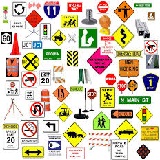 Drive America Drive America
Planning to drive in America? Learn the rules and
regulations. Great English reading practice. |
|